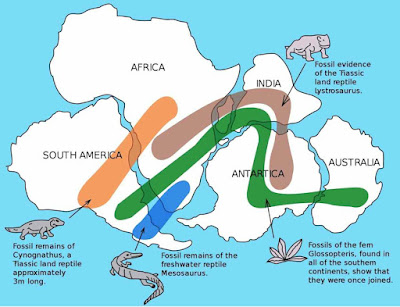Pangaea was a supercontinent that existed during the late Paleozoic and early Mesozoic eras.
It assembled from earlier continental units approximately 335 million years ago, and it began to break apart about 175 million years ago. In contrast to the present Earth and its distribution of continental mass, much of Pangaea was in the southern hemisphere and surrounded by a superocean, Panthalassa.
Pangaea formed through a gradual process spanning a few hundred million years. Beginning about 480 million years ago, a continent called Laurentia, which includes parts of North America, merged with several other micro-continents to form Euramerica. Euramerica eventually collided with Gondwana, another supercontinent that included Africa, Australia, South America and the Indian subcontinent.
The name "Pangaea/Pangea" is derived from Ancient Greek pan (πᾶν, "all, entire, whole") and Gaia (Γαῖα, "Mother Earth, land")
 |
| The distribution of fossils across the continents is one line of evidence pointing to the existence of Pangaea. |
Fossil evidence for Pangaea includes the presence of similar and
identical species on continents that are now great distances apart. For
example, fossils of the therapsid Lystrosaurus have been
found in South Africa, India and Antarctica, alongside members of the
Glossopteris flora, whose distribution would have ranged from the polar
circle to the equator if the continents had been in their present
position; similarly, the freshwater reptile Mesosaurus has been found in
only localized regions of the coasts of Brazil and West Africa.
Paleomagnetic study of apparent polar wandering paths also support the theory of a supercontinent. Geologists can determine the movement of continental plates by examining the orientation of magnetic minerals in rocks; when rocks are formed, they take on the magnetic properties of the Earth and indicate in which direction the poles lie relative to the rock.
The continuity of mountain chains provides further evidence for Pangaea. One example of this is the Appalachian Mountains chain, which extends from the southeastern United States to the Caledonides of Ireland, Britain, Greenland, and Scandinavia.
There were three major phases in the break-up of Pangaea. The first phase began in the Early-Middle Jurassic (about 175 Ma), when Pangaea began to rift from the Tethys Ocean in the east to the Pacific in the west.
The second major phase in the break-up of Pangaea began in the Early Cretaceous (150–140 Ma), when the minor supercontinent of Gondwana separated into multiple continents (Africa, South America, India, Antarctica, and Australia).
The third major and final phase of the break-up of Pangaea
occurred in the early Cenozoic (Paleocene to Oligocene). Laurasia split
when North America/Greenland (also called Laurentia) broke free from
Eurasia, opening the Norwegian Sea about 60–55 Ma.
What can also be observed in relation to tectonic plates and Pangaea, is the formations to such plates. Mountains and valleys form due to tectonic collisions as well as earthquakes and chasms. Consequentially, this shaped Pangaea and animal adaptations.
When Pangaea separated, the reorganization of the continents changed the function of the oceans and seaways. The restructuring of the continents, changed and altered the distribution of warmth and coolness of the oceans. When North America and South America connected, it stopped equatorial currents from passing from the Atlantic Ocean to the Pacific Ocean.
The creation of the new ocean that caused a circumpolar current eventually led to atmospheric currents that rotated from west to east. Atmospheric and oceanic currents stopped the transfer of warm, tropical air and water to the higher latitudes.
There is evidence to suggest that the deterioration of northern Pangaea contributed to the Permian Extinction, one of Earth’s five major mass extinction events, which resulted in the loss of over 90% of marine and 70% of terrestrial species.
Paleomagnetic study of apparent polar wandering paths also support the theory of a supercontinent. Geologists can determine the movement of continental plates by examining the orientation of magnetic minerals in rocks; when rocks are formed, they take on the magnetic properties of the Earth and indicate in which direction the poles lie relative to the rock.
The continuity of mountain chains provides further evidence for Pangaea. One example of this is the Appalachian Mountains chain, which extends from the southeastern United States to the Caledonides of Ireland, Britain, Greenland, and Scandinavia.
There were three major phases in the break-up of Pangaea. The first phase began in the Early-Middle Jurassic (about 175 Ma), when Pangaea began to rift from the Tethys Ocean in the east to the Pacific in the west.
The second major phase in the break-up of Pangaea began in the Early Cretaceous (150–140 Ma), when the minor supercontinent of Gondwana separated into multiple continents (Africa, South America, India, Antarctica, and Australia).
What can also be observed in relation to tectonic plates and Pangaea, is the formations to such plates. Mountains and valleys form due to tectonic collisions as well as earthquakes and chasms. Consequentially, this shaped Pangaea and animal adaptations.
When Pangaea separated, the reorganization of the continents changed the function of the oceans and seaways. The restructuring of the continents, changed and altered the distribution of warmth and coolness of the oceans. When North America and South America connected, it stopped equatorial currents from passing from the Atlantic Ocean to the Pacific Ocean.
The creation of the new ocean that caused a circumpolar current eventually led to atmospheric currents that rotated from west to east. Atmospheric and oceanic currents stopped the transfer of warm, tropical air and water to the higher latitudes.
There is evidence to suggest that the deterioration of northern Pangaea contributed to the Permian Extinction, one of Earth’s five major mass extinction events, which resulted in the loss of over 90% of marine and 70% of terrestrial species.
http://www.geologyin.com/2018/02/facts-about-pangaea-most-recent.html#Oh1tuQtgKbbXXuPu.99 Follow us: @GeologyTime on Twitter

